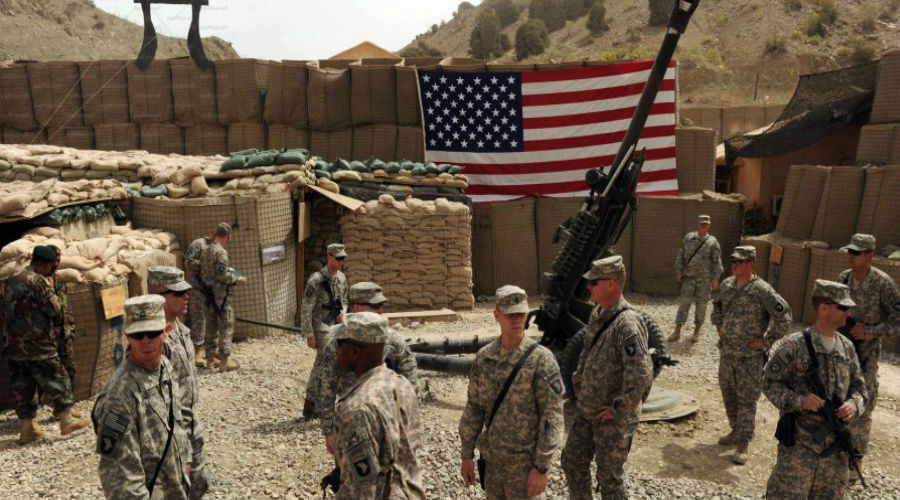In a surprise move, the United States decided to use one of its most powerful non-nuclear weapons in its war on terrorism. On April 13, 2017, the US military dropped a non-nuclear bomb MOAB (officially the GBU-43 or “Massive Ordnance Air Blast” but nicknamed the “Mother Of All Bombs”) on a system of tunnels and caves used by ISIS-K, or ISIS Khursanan. ISIS-k is the provincial division of ISIS, in Achin district, Nangarhar province, Afghanistan. Up to 36-suspected ISIS militants were killed by the 9,797kg GPS-guided munition dropped for the first time in combat, according to US estimates.
The move perhaps indicates that the US administration of President Donald Trump is bent on shaping a new strategy for the coming period. The use of the powerful bomb coincided with Vice President Mike Pence’s surprise visit to the Korean Demilitarized Zone that separates communist North Korea from democratic South Korea. Pence stated that “the era of strategic patience is over” and that “all options are on the table”, referring to North Korea’s insistence on developing nuclear weapons and missiles capable of reaching the US.
Without a doubt, it would not be possible to dissociate the new strategy from the April 7, 2017 US missile strike on Syria's Shayrat airbase, launched in retaliation for an April 4, 2017 chemical attack by the Bashar Assad regime on the town of Khan Sheikhoun in northern Syria. What the two strikes have in common is that they both were not expected and that the US administration launched the two strikes before getting on a political track for solving the crises in Syria and Afghanistan.
Various Messages
The recent use of such a MOAB bomb against ISIS in Afghanistan has put the US war in Afghanistan, which started 16 years ago in the immediate aftermath of the 9/11 attacks, under the spotlight once again, where Washington seeks to curtail ISIS presence in Afghanistan. According to US estimates, the terror organization’s 700-fighters strong force in Afghanistan, at the most, can become an incubator for militants driven from ISIS bastions in Raqqa and Mosul cities in Syria and Iraq, where military operations against the organization continue to escalate.
This may explain a recent Wall Street Journal’s revelation of Pentagon’s plans to deploy approximately 300 US Marines to Helmand province in southern Afghanistan. However small, the deployment of the force indicates that Washington – which, by 2014, had withdrawn more than 90,000 troops from Afghanistan leaving only 9,000 stationed there for training and advisory missions - has taken a path towards fresh escalation in Afghanistan’s heartland. In the first three months of 2017, the US Air Force dropped 450 bombs on the country, compared to 1,300 for all of 2016, according to the US Air Forces Central Command (AFCENT) open-source database of such strikes.
Within this context, General John W. Nicholson, the US commander in Afghanistan, said that ISIS militants are using IEDs, bunkers and tunnels to thicken their defense, and that MOAB was used to reduce these obstacles and maintain the momentum of the US offensive against ISIS-K in southern Nangarhar province. Several U.S reports are focusing on the possibility that this ISIS complex was built to house more militants in Afghanistan.
Moreover, the current US administration further seeks to send across messages to the American people that unlike the Obama administration, it will launch military strikes in crisis-hit countries even before it undertakes a political approach to these crises. This suggests that the new administration seeks to reaffirm its commitment to ending the strategic patience policy that was solidified by the former administration.
On the other hand, the move sends indirect messages to regional and international powers such as Russia, Iran and North Korea, and non-state factors such as the Iran-allied Hezbollah, that this US administration can carry out its threats.
Multiple Contrasts
Some tend to believe that Washington is going to use this type of powerful bombs in other regions, including the border between Syria and Iraq. However, such a move can face several obstacles, i.e. the Syrian-Iraqi border is less rugged than the Afghan-Pakistan border areas, and the use of such bombs can, according to several reports, damage the Tabqa Dam, east of Raqqa, which was retaken after U.S. and British troops carried airborne landings to support the so-called Syrian Democratic Forces (SDF). Other obstacles would include the fact that it would be difficult to approach the Raqqa’s city center without risking high civilian casualties. However, overall, these potential obstacles would not prevent the US administration from bringing about a radical “change” in Raqqa or target ISIS’ command centers and underground operations in the coming period.
However, another scenario cannot be ruled out. According to Steven J. Zaloga, a top analyst at the Teal Group Corporation, one advantage of using the MOAB, as opposed to other precision guided weapons like a Tomahawk or the Joint Direct Attack Munition (JDAM), is extremely high explosive content that creates a large blast area over the surface of the battlefield. The pressure from that explosion likely detonated many improvised explosive devices stored by ISIS.
In conclusion, it can possibly be safe to say that the offensive against ISIS-K in Afghanistan following the missile strike on the Shayrat airbase in Syria, is an indication that Washington is bringing about notable changes to its policy towards major regional crises and issues in the Middle East, most importantly the conflict in Syria and the war on ISIS.


